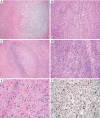Fibroblastic sarcomas of the mediastinum
- PMID: 35118294
- PMCID: PMC8794436
- DOI: 10.21037/med-20-44
Fibroblastic sarcomas of the mediastinum
Abstract
Primary mediastinal fibroblastic sarcomas constitute a rare, heterogeneous group of neoplasms, mainly including solitary fibrous tumor (SFT) (benign and malignant), low grade fibromyxoid sarcoma (LGFMS), adult fibrosarcoma (FS), myxofibrosarcoma, sclerosing epithelioid FS, etc. Although morphologically diverse, they frequently have similar clinical and radiological features. Overlapping of histological features among these neoplasms can make it challenging for pathologists to come to an accurate diagnosis. In addition, other mesenchymal neoplasms and spindle cell neoplasms of the epithelial cell origin can occur in the mediastinum. Immunostaining and molecular testing are important ancillary studies to confirm or rule out primary mediastinal fibroblastic neoplasms. SFT and LGFMS occur more often than adult FS in the mediastinum and both have reliable immunostaining markers STAT6 and MUC4, respectively, and unique molecular changes. The incidence of adult FS has decreased dramatically due to recognition of morphologically and genetically distinctive subtypes of fibroblastic sarcoma and better understanding of mesenchymal and non-mesenchymal mimickers. Adult FS is extremely rare and a diagnosis of exclusion. Adult FS can be rendered only after careful histological examination and thorough ancillary studies have ruled out all its mimickers. This article is focused on reviewing clinicopathological features, immunostaining, molecular changes, prognosis and differential diagnosis of SFT, LGFMS, and adult FS. Correct diagnosis is crucial for oncologists to make appropriate clinical management plans.
Keywords: Fibroblastic sarcoma of the mediastinum; adult fibrosarcoma (adult FS); low grade fibromyxoid sarcoma (LGFMS); solitary fibrous tumor (SFT).
2020 Mediastinum. All rights reserved.
Conflict of interest statement
Conflicts of Interest: Both authors have completed the ICMJE uniform disclosure form (available at http://dx.doi.org/10.21037/med-20-44). The series “Mediastinal Sarcomas” was commissioned by the editorial office without any funding or sponsorship. The authors have no other conflicts of interest to declare.
Figures



References
Publication types
LinkOut - more resources
Full Text Sources
Research Materials
Miscellaneous
